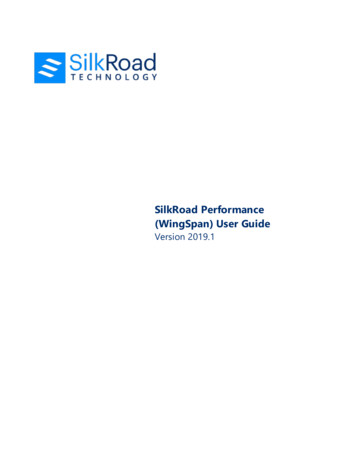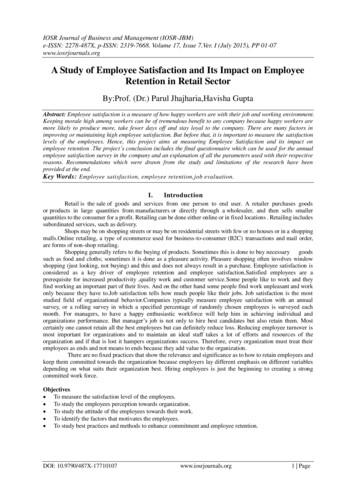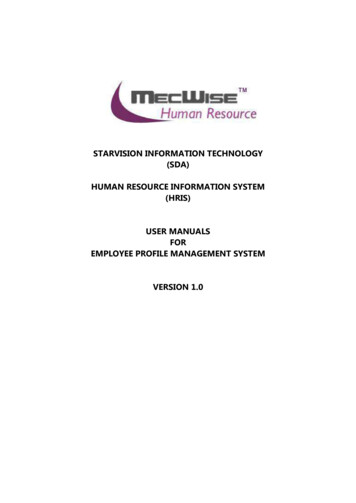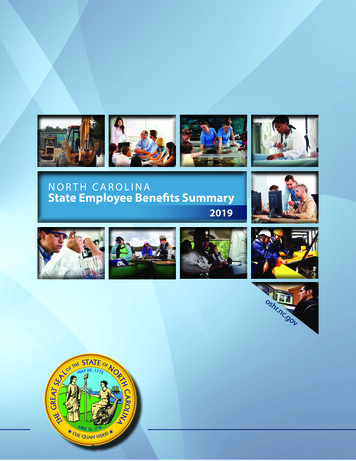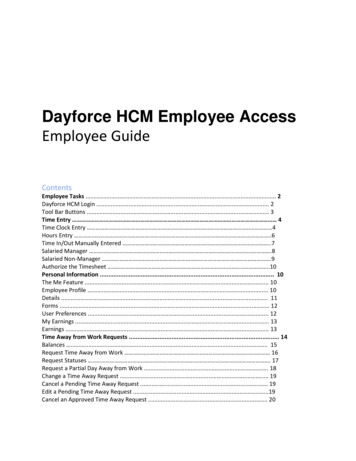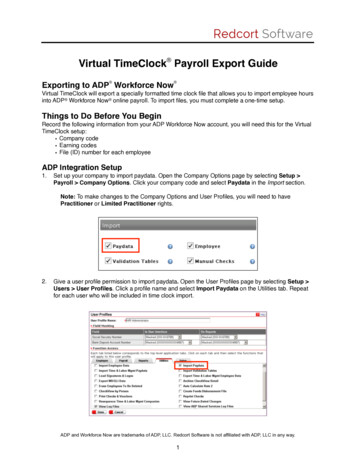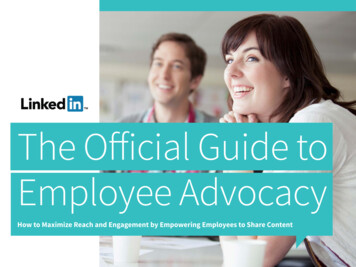
Transcription
The Official Guide toEmployee AdvocacyHow to Maximize Reach and Engagement by Empowering Employees to Share Content
The Official Guide to Employee AdvocacyIntroductionEmployee advocacy—empowering your employees to sharesmart, quality content with their own social networks—is stilla nascent concept. Sophisticated organizations know that bymaking it easy for employees to share content they are naturallyextending their content reach and engagement, and connectingmore authentically with their audiences. That’s because, onaverage, employee networks have 10x more connections thana company has followers. Plus, according to the Edelman TrustBarometer, people are 3x more likely to trust company informationshared by an employee than that shared by a CEO. Analysisof LinkedIn network activity backs this up—the click-throughrate (CTR) on a piece of content is 2x higher when shared by anemployee versus when shared by the company itself.Tapping into the power of employees reaps tremendous benefitsfor your company, such as increasing brand awareness, attractingtop talent, and generating sales leads. Likewise, a strongadvocacy program benefits employees as well, helping them buildtheir professional reputations, grow their networks, and becomemore engaged with your company. At the end of the day, measuringresults is the best way to see the value of employee advocacy.While measuring engagement is important, you’ll also want tounderstand which audiences you are reaching, how the programimpacts your key business metrics, and how your employees aregrowing their own networks and professional reputations.In this e-book you’ll find everything you need to know aboutemployee advocacy. Read on to learn more about the power ofyour employees’ networks, how to execute your own program,and best practices from companies who are doing this welltoday. By the end of this guide, you’ll be all set to begin seeingthe benefits of employee advocacy for yourself!2
The Official Guide to Employee AdvocacyTable of Contents04 12 21 26How EmployeeAdvocacy DrivesYour BusinessHow to Buildan EmployeeAdvocacy ProgramHow to Turbocharge Ask the ExpertsYour Program withLinkedIn ElevateFor Marketing: AuthenticallyStep 1: Set your program01. Maximize impact withConclusion: Mobilize yourreach and engage more ofgoals and content strategyhigh employee adoptionworkforce to becomeand engagementbrand advocatesyour audienceStep 2: Select yourFor Sales: Crush quota by turningemployee audiencesalespeople into social sellersdeliver the right content withStep 3: Demonstrate theFor Talent: Attract quality02. Optimize your program andinsights from LinkedIn.comvalue to employees03. Get the full picture of resultsemployees to your organizationStep 4: Launch your programStep 5: Keep employees engagedStep 6: Measure your results3
The Official Guide to Employee AdvocacyMarketingAuthentically Reach and Engage More of Your AudienceAs a marketer, you need to reach and engagemore of your target audience to ultimatelydrive business results. If you’re not tappinginto your colleagues’ social networks, you aremissing out on a huge opportunity to expandyour reach, and better engage prospectivecustomers.Consider this:While only 3% of employees share contentabout their company, those shares areresponsible for driving a 30% increase in thetotal engagement a company sees.Why is this so? On average, a company’semployees’ networks are at least 10x largerthan a company’s follower base. And, whenyour colleagues share a post, it is seen as 3xmore authentic, which helps the message cutthrough the clutter of advertising people seeevery day. People are more likely to engagewith content when it comes from someonethey know than from a company. Whenemployees share content they typically see aclick-through rate that is 2x higher than whentheir company shares the same content.But don’t just take our word for it. Hereare real-world examples of the power ofemployee advocacy in action.Total Engagementwith Company Content3%of employeesshare contentabout theircompany, butthey’reresponsible fordriving a 30%in the totalengagementa company sees.4
The Official Guide to Employee AdvocacyHow Visa Empowers Employees to Enhance the Visa BrandVisa launched an employee advocacy program in partnership with LinkedInElevate to shine a light on the new and interesting things that are beingdone in local markets around the globe, and to position themselvesand their employees as thought leaders. Since launching Elevate, Visaemployees are sharing 6x more than before. Their shares have alsoinfluenced 4x more Company Page followers.5“People consume information in manydifferent ways, and it’s important to reachthem in the way they want to be reached.With employees as busy as they are, if youcan deliver approved company content in away that’s interesting and engaging, you’regiving people an easy opportunity to share itin safe way.”Lucas Mast, Vice President Social Corporate Media, VisaHow DLA Piper Boosts Brand AwarenessDLA Piper, a global multinational law firm, has been using Elevate tostrengthen its lawyers’, partners’, and professionals’ brands and increaseawareness of the firm. Since they started using Elevate, DLA Piper’s lawyers,partners, and professionals are sharing 6x more than before, and haveinfluenced 3x as many Company Page followers and 4x as many CompanyPage views than before using Elevate.LinkedIn Elevate provides marketers with demographic informationabout who has engaged with content — to help you understandwhether what you’re sharing is resonating with your target audience“We have always had a strong content-drivenculture. We recognized early on that peopletend to engage more with content shared byindividuals than employers. Elevate helpsour people discover and share content thatpositions them as thought leaders, helpsthem connect with clients and prospects, andfavorably positions our brand.”Barbara Taylor, CMO, DLA Piper
The Official Guide to Employee Advocacy6SalesCrush Quota by Turning Salespeople Into Social SellersNow let’s explore how employee advocacy can impact sales teams. B2B buyers are turningto social media channels on their path to purchase. In fact, an IDC survey found that 75%of B2B buyers use social media to make purchasing decisions. And an even higher number(84%) of C-level executives consult these channels during the purchasing process. With therise of the empowered buyer, more companies are embracing social selling—leveragingsalespeople’s social networks to find the right prospects, build trusted relationships, andultimately achieve their sales goals. By developing and nurturing their social networks,sales reps position themselves to be top of mind once a prospect is ready to buy.“On average, we saw that traffic generated by employees converted atabout 2.5x the rate of traffic generated by the brand. In fact, employeeseach generated more than 100,000 of sales. In essence, we got moretraffic that converted better at a lower cost.”Chris Boudreaux, Digital Marketing and CRM Advisory Executive, Author of TheMost Powerful Brand On Earth75%of B2B buyers use social mediato make purchasing decisions.
The Official Guide to Employee AdvocacyAs part of this shift in selling, many companies are encouraging theirsales teams to share content on social networks. The sales reps whodo so are seeing results. Salespeople who regularly share are 45%more likely to exceed quota. Plus, leads developed through employeesocial marketing convert more frequently than others and sociallyengaged companies are 57% more likely to see increased sales leads.7Salespeople who regularlyshare are 45% more likely toexceed quota.45%“A formal employee advocacy program helps shorten the salescycle. Nearly 64% of advocates in a formal program creditedemployee advocacy with attracting and developing newbusiness, and nearly 45% attribute new revenue streams toemployee advocacy.”Hinge Research Institute, Understanding Employee Advocacy onSocial MediaOn average, regular users ofLinkedIn Elevate see theirSocial Selling Index (SSI)increase 19% and growtheir networks 4x fasterthan before.
The Official Guide to Employee AdvocacyHow CEB is Enabling Sales Teams to Share ContentCEB, a best-practice insight and technology company, first startedusing LinkedIn Elevate to help its sales force become better socialsellers. They were so successful that CEB shortly rolled out theplatform to its talent acquisition team. Employees using Elevateare sharing 3x more than before. As a result, they are receiving 3xmore profile views, gaining 4x more connections, and influencing3x more company page views.“Elevate automatically provides me with relevantcontent I can easily share with my connections to staytop of mind. Since I’ve started using Elevate, I’ve had alot more traction with people liking and commentingon my posts. It gives me satisfaction to know thatexecutives are seeing our work, and it’s having animpact on our brand.”Jenna Robb, Senior Business Development Manager,CEB’s Marketing and HR practices8How PTC is Creating Social SellersPTC, a global provider of technology platforms and solutionsthat transform how companies create, operate, and service the“things” in the internet of things (IoT), wanted to enable its salesprofessionals to be social sellers. To this end, sales and marketingteams have worked together to empower PTC’s employees tobecome thought leaders with a mix of branded and unbrandedcontent, tracking engagements with key accounts throughLinkedIn Elevate. The PTC sales force is now sharing content7x more than before, resulting in 3x more profile views and3x more connections.“As we were entering into new complex markets withnew solutions, we wanted to give our sales forcethe tools and content to engage their professionalnetworks, establishing credibility and sharinginformation with customers and prospects alike.Elevate enables our sales force to become true socialsellers and maximize their impact with key accounts.”Julian Lee, Sales Enablement Director, EMEA, PTC
The Official Guide to Employee AdvocacyTalentAttract Quality Employees to Your OrganizationYour employees are your most authenticadvocates, and their networks are filled withprospective talent. When your employees sharecontent about where they work and what theydo, it’s far more engaging than when it comesfrom your company alone.Employee advocacy fundamentally changesthe way companies attract and engage talent.Companies with socially engaged employeesare 58% more likely to attract top talent and20% more likely to retain them. The companyrelated content your employees share helpsbuild affinity with the talent pools you’relooking to hire and ultimately accelerates thecandidate journey.58%20%more likely to attracttop talentmore likely to retaintop talent9
The Official Guide to Employee AdvocacyEven when content shared by employees is not directly related to yourcompany, your employer brand benefits. That’s because, when youremployees are seen as thought leaders in their space, your company is seenas a leader by association. And that exposes your brand to more peoplewho are likely to become interested in your company and apply for a job.Remember: For every piece of content an employee shares on LinkedIn,at least one person will view your job postings.An employee advocacy program also increases employeeengagement. Employees at socially engaged companies are27% more likely to feel optimistic about their company’s futureand 15% more likely to feel connected to co-workers beyondtheir core teams.LinkedIn and Altimeter Relationship Economics Report56% of global talent leaders say talent brand is a top priority. A strongbrand has a significant impact on hiring great talent, reducing cost perhire and eventually lowering employee turnover.Every 6 pieces of content shared bya LinkedIn member influences:3 peopleto view your LinkedIn Company Page1 new followerof your LinkedIn Company Page6 peopleto view your jobs posted on LinkedIn10
The Official Guide to Employee AdvocacyHow CH2M is Partnering With Employees to Engage the Right TalentCH2M, an engineering and consulting firm, realized that the relationships theiremployees had with their networks were the key engine to recruitment forthe company, especially for engineers. CH2M decided it needed an easy andeffective way to empower its employees to share content to strengthen thoserelationships. CH2M chose LinkedIn Elevate because it was so easy to use andprovided the data they needed to understand what talent pools they werereaching. Employees are now sharing 8x more than before, and their sharingis driving 4x more job views and 3x more job applications.How Unilever is Building Their Employer Brand on aGlobal Scale Through Their Employees’ VoicesUnilever, a global consumer goods powerhouse whose valuesdefine how they work, recognized that their employees weretheir biggest brand ambassadors. They wanted a way toempower them to share their voice with the world and, inturn, share the Unilever mission. They’ve been using LinkedIn Elevate to drivea best-in-class content strategy, and employees are now sharing 16x morethan before and driving 5x more job views.“Elevate evolves each month, adding new features, providing a betterproduct and user experience for employees who want to show the worldtheir Unilever. We can’t wait to see what the future holds,”Leena Nair, Chief HR Officer, Unilever11“Engineers are generallymore hesitant to be involvedon social. But once theywere on the Elevateplatform and saw howeasy it was, coupled withseeing the results of theirsharing such as connectionrequests and profile views,their engagement levelsskyrocketed.”Nora Davis, Brand Experience andContent Marketing Specialist, CH2M
The Official Guide to Employee AdvocacyHow to Buildan EmployeeAdvocacyProgramSo, you’re all set to launch your own employee advocacy program.There are several steps to keep in mind before simply providingcontent for employees to share. First, it’s important to realize thatemployees may need to be educated on how sharing impactstheir personal brands. Second, employees are often unsure aboutwhat they should and shouldn’t say about their company in socialmedia channels. That’s why you need a formal plan and programin place to empower employees to share content.12
The Official Guide to Employee Advocacy13Step 1Set Your Program Goals and Content StrategyIt’s essential to get the foundations of your company’s employee advocacyprogram right from the get-go. Start by defining your program goals.Here are some examples to get you started thinking about yourorganization’s goals:MarketingSalesRecruitingReach and engage more ofyour target audienceNurture customers and prospectsin your salespeoples’ networksBoost awareness of and engagement withyour employer brandIncrease brand awarenessand followersCreate social sellers and position yoursalespeople as partnersIncrease job views and applicationsDrive quality hiresDrive leads for salesDrive more leads and closemore deals
The Official Guide to Employee Advocacy“It’s really important to develop a solid content strategybefore asking your employees to advocate for your brand.You need to identify curators who can create content thatis both snackable and aligned to what sales reps want totalk about with prospective customers. This can changefrequently so you need to constantly get feedback andrefine your approach.”Zehra Zaidi, Senior Marketing Communications Manager,CEBIn addition to program goals, you also want to set your contentstrategy. You need quality, relevant content that employees willbe interested in discovering and sharing. Strive for a balance ofcompany-related, industry-related, and general content. Here’sa proven formula for success: At most, make 25% of your contentcompany-specific. Since your goal is to drive engagement withemployees and their networks, you need to provide informationthat syncs with their interests—which extend beyond what ishappening at your company.4-1-1 ContentRulefor every 6 pieces ofcontent you share withemployees, 4 should bethird-party/curated,1 should be owned/company-related, 1should be promotional.14
The Official Guide to Employee AdvocacyStep 2Select Your Employee AudienceOnce you have your goals in place, you’ll want to identifywhich employee groups, departments, and functions withinyour company can help you achieve these goals. Ideally, everyemployee at your company will participate. But to start, focusyour efforts on the employees who are already active on socialmedia. As your program matures and grows, expand to includeadditional groups, using employees from this first group asambassadors for those who aren’t as socially savvy.It’s also important to secure leadership support before startingan employee advocacy program. When senior managers andexecutives lead by example, employees are more likely to see thisas a priority and understand the importance of participating.LinkedIn Elevate helps you identify your existing social starsand which departments and functions have the most appetitefor sharing, so you can roll out (and scale) successfully.15
The Official Guide to Employee Advocacy“While all workers understand tosome extent what’s going on, they’reskeptical about adopting social toolsand processes just for the sake ofdoing something new. All employees,but especially the incomingmillennials, want to know whysomething is useful. Without thisbuy-in, adoption becomes costlyand time-consuming.”Cheryl Burgess, Co-Founder andCEO of Blue Focus Marketing, andco-author of the best-selling book,The Social EmployeeStep 3Demonstrate the Value to EmployeesYour program and audience strategy are the foundation; now it’stime to educate employees on what’s in it for them. Outline whyit’s important that they begin sharing content regularly.Tell them they can: Build their professional reputations. Employees who sharequality content regularly can build visibility and positionthemselves as thought leaders in their industry. They also getmore LinkedIn profile views and are able to grow their networksmore quickly. Impact the business. Employee sharing helps organizationsbe more successful. When employees share content, theyhelp drive awareness of the brand, sales for the company andsupport future growth by attracting quality hires.16
The Official Guide to Employee AdvocacyTo make sure everyoneunderstands the value ofsharing content, hold socialmedia 101 trainings, such aslunch-and-learns, webinars, orshort on-demand videos. Trainemployees on how to build atop-notch LinkedIn profile.Clearly outline your socialmedia guidelines to allayany concerns. No time tocreate a dos and don’ts listfrom scratch? Lift socialmedia guidelines from yoursocial media and corporatecommunications teams.17Top 5 Tips for Building a Strong LinkedIn Profile1.2.Upload a professional photo.Profiles with photos receive a 40% higher InMailresponse rate.86%Write a descriptive headline.After the photo, the headline is the first thing people lookat in a profile.3.Include a summary and experience.Employees should tell their story from the perspective ofsomeone trying to determine whether or not they want todo business with the company or respond to an InMail.4.Personalize the LinkedIn web address.By creating a URL that closely matches their names,employees will be more easily found in searchengine results.5.Share updates prospects or customers will findinsightful, useful, or provocative.In addition to providing links to the articles, employeesshould comment on what they share without being tooself-promotional.of employees in a formalemployee advocacy programsaid it has had a positiveimpact on their own careers.Plus, LinkedIn Elevate usersgrow their networks 3xfaster and boost their profileviews by 6x.
The Official Guide to Employee AdvocacyStep 4Launch Your ProgramYou’ve set your goals and educated your employees on thebenefits. Now all that’s left to do is launch! Here are three keyelements to incorporate into your “go-live” plans:1. Tap into your existing communication channels.This can include email, signs and posters, intranet postings, atown hall or similar event, or any other heavily used channel whereyou can engage a captive audience.2. Get leadership involved whenever you can.Include senior executives across departments and arm them withmaterials to share with their groups. Also encourage their ongoingparticipation so they serve as role models for employees.Remember:Employee advocacy is not a one-and-done exercise; it’s anew way of engaging that requires sustainability formaximum impact.18
The Official Guide to Employee AdvocacyStep 5Keep Employees EngagedOnce you’ve launched your employee advocacy program,you need to keep the momentum going. You can do so bysharing regular reminders about the program and success yourcompany and your employees are seeing.Regularly reinforce the impact employees are driving.Think of ways to recognize employees for sharing content andparticipating in the program. You might call out employeeswith the highest engagement rates by profiling them in yourcorporate newsletter.Encourage mobile. Our research shows that mobile usersshare more than non-mobile users.Refine your content strategy. Since content relevance iscrucial for inspiring employees to share, you should regularlyreview your content strategy analytics to understand howyou’re doing and tweak as needed.Motivate Employees Fromthe Get-GoThe content of your launchcommunications is just asimportant as the channelsyou choose. A LinkedInElevate analysis showsthat driving certain useractivities during the firstweek can help you maintainstrong sharing and activityrates over time. Encourageemployees to download amobile app, if available, andto share at least 2x in theirfirst week.19Through LinkedIn Elevate,you can take advantageof several built-in featuresthat help keep employeesengaged, includingnotifications and reputationmetrics around profile viewsand engagements.
The Official Guide to Employee AdvocacyStep 6Measure Your ResultsRemember those goals you set at the beginning? It’s now time totrack how your employee advocacy program is performing againstthose metrics.At the most basic level, you’ll want to see engagement rateson shared content. You also need insight into employee activitylevels by tracking the number of active users, share rates, andengagement by content type.And finally, you’ll want to understand downstream outcomes suchas demographics of those you’ve engaged, page views, and theimpact on new followers. With the right platform, you will evenbe able to see how all this engagement has driven new site traffic,new hires, and additional sales.20
The Official Guide to Employee Advocacy21How to TurbochargeYour Program withLinkedIn ElevateLinkedIn Elevate helpscompanies empower theiremployees to share qualitycontent that, in turn, driveshiring, marketing, and salessuccess. On average, LinkedInElevate users share 5x morethan they did before and, asa result, influence 3x moreCompany Page views, 2x moreCompany Page followers, and4x more job views.As the only employeeadvocacy provider that’s alsoa social network and contentplatform, only LinkedIn Elevateprovides the employee andcontent insights neededto successfully set up andoptimize your program tomaximize your performanceand results.5xLinkedIn Elevate users sharemorethan they did before, resulting in4xmore job views3xmore CompanyPage views2xmore CompanyPage followers
The Official Guide to Employee AdvocacyLinkedIn Elevate in ActionHere’s How It Works:1. Curate2. Share3. MeasureSuggest articlesto employeesEmployees share to theirsocial networksMeasure programperformance22
The Official Guide to Employee AdvocacyMaximize impact with high employee adoption and engagementLinkedIn Elevate was built with employees in mind and leverages insights from theworld’s largest professional network to drive unparalleled engagement.Launch with your social stars. Elevate knows which of your employees are mostactive on social today and can provide you with a list to help jump start yourprogram.Drive adoption with the help of LinkedIn. Elevate targets your employees acrossLinkedIn.com with feed updates, mobile promotions and InMails to remind andengage employees.Drive regular engagement with reputation rewards. Elevate reinforces thevalue of sharing to employees by helping them see how sharing is building theirprofessional reputation. Users see metrics around the types of professionals,industries and companies they’ve influenced, as well as how sharing has helpedthem grow their network.23
The Official Guide to Employee AdvocacyOptimize your program and deliver the right content with insightsfrom LinkedIn.comElevate includes insights from LinkedIn.com to help companies curatesuccessfully and see the business impact of their program.Curate with an advantage. Get daily suggestions of content that is resonating with your targetaudience to help you succeed before you start. Smart algorithms learn your employees’ content preferences andprioritize recommendations based on their sharing behavior.Quantify your target influence. Elevate shows you the industries, companies and functions that areengaging with your employee’s shares — to help you see how wellyou’re engaging your target.Get the full picture of results. Get real impression data and actual engagement rates to helpunderstand and optimize performance. See how Elevate sharing is driving impact — such as traffic to yourwebsite, followers of your company page and even new hires.2450%Elevate teaches employees tobe social. More than 50% ofElevate users today had zerosharing activity in the 90days prior to using Elevate.
The Official Guide to Employee Advocacy25ConclusionMobilize Your Workforce to Become Brand AdvocatesWhen your company empowers itsemployees to be social professionals, itdoesn’t just enhance your employees’professional reputations—it changes thetrajectory of your business as well. Whetheryour company wants to improve contentmarketing, talent acquisition, or leadgeneration, your employees’ authenticityand social engagement can help drivemeaningful business results.Ready to get your organization starteddown the path to better company andemployee engagement? Put into play thebest practices in this e-book, and call uponLinkedIn Elevate to power your employeeadvocacy strategy and program.Jump-start employee advocacy in3 easy steps:123Identify a crossfunctional group ofemployees who you wantto regularly share content.Educate employeeson the benefits ofsharing (building theirprofessional reputationsand making an impactto the company), andprovide them with socialmedia guidelines.Make it easy foremployees to shareby providing themwith relevant contentin a weekly emaildigest, along with prepopulated comments toinclude in their posts.
The Official Guide to Employee Advocacy26Ask the ExpertsNeal SchafferSocial Media Speaker and Author of Maximize Your Social: A One-Stop Guide to Building a Social MediaStrategy for Marketing and Business Success, and Maximizing LinkedIn for Sales and Social Media MarketingQ. How has the concept of employee advocacy evolved?A. When “employee advocacy” began to be used as a keyword,businesses were thinking very simplistically. For example, they’dthink, “If each employee has 100 connections and we can getthem to share a message with each one, we can really amplify ourreach.” But we’ve come a long way since then.Another benefit is that it provides salespeople with the contentthey need to share for their own branding.When companies go full-on with employee advocacy and trulylisten to their employees and make their employees a key part ofthe program, it has the potential to change the company culturein a lot of ways. As the program becomes bigger and encompassesmore people, it becomes a very, very powerful presence.Q. What advice would you give a company embarking on anemployee advocacy program?A. First, start small but recruit employees who are already savvyat using LinkedIn and other social media channels, so they willeventually evangelize your program. Second, educate and trainemployees on the value of the program and how to use the tools.Third, plug your employee advocacy program into the content thatyou share as a brand. Finally, use input from your employees toimprove the employee advocacy program and all outward-facingmarketing and PR activities.Q. What benefits can companies realize by implementing anemployee advocacy program?A. The benefits span the organization. The marketing departmentsees an amplification of content and brand voice. There is verylittle overlap between the followers or fans of a brand and thoseof their employees’ networks. So, companies are able to tap into abrand new—and trusted—audience.An advocacy program is also a great way to engage employeesand keep or make them happy. People love to be part of biggercompany initiatives and love to be heard.
The Official Guide to Employee AdvocacyAsk the ExpertsMark BurgessPresident and Founder, Blue Focus Marketing and author of The Social EmployeeQ. How do you define employee advocacy?A. In the current social media climate, people don’t want to talkto a brand. They want to talk to another person. With employeeadvocacy, brands empower their employees to represent boththe brand and themselves in an authentic way. The goal isto create engagement: a rich, two-way dialogue that is verydifferent from traditional, push-based branding efforts.Q. How have you seen this space evolve?A. We’ve been seeing more and more companies and brandsbecoming interested in having authentic conversations.But the biggest change we’ve seen is the thirst for the how.There are a lot of content and workshops around employeeadvocacy springing up, and we expect this trend to continueto grow. There are just too many benefits for employeesand companies for employee advocac
lot more traction with people liking and commenting on my posts. It gives me satisfaction to know that executives are seeing our work, and it’s having an impact on our brand.” Jenna Robb, Senior Business De


